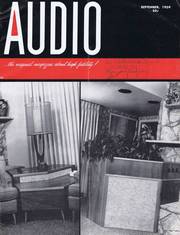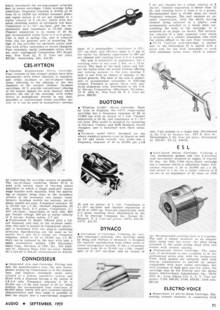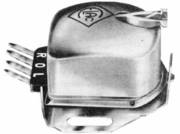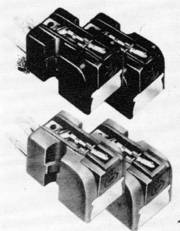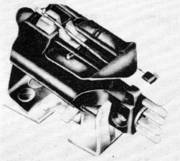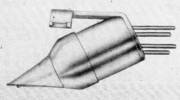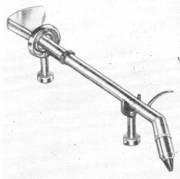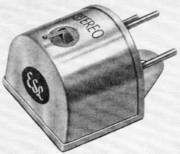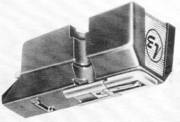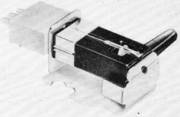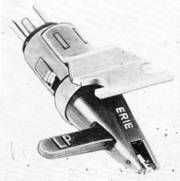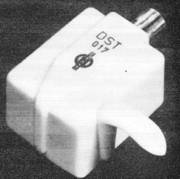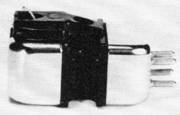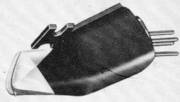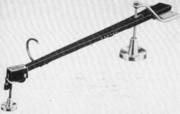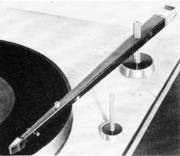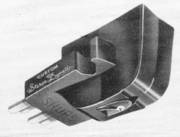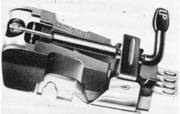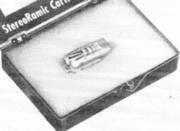Erläuterungen zu diesen US-AUDIO Seiten der 1950er Jahre
Die hier stehenden amerikanischen Artikel aus 1959 (aus der US-AUDIO) sind teilweise sehr gewöhnungsbedürftig, weil sie erstens aus einer längst vergangenen Zeit stammen und zweitens, weil dort in den USA ganz "anders" gedacht wurde als bei uns in Old Germany oder in Europa.
Vergleichbar mit unseren deutschen Hifi-Magazinen etwa ab 1962 ist jedoch, daß auch diese Zeitschrift ihre Anzeigen- Kunden und -Leser (be- oder ab- ?) werben mußte. - Weiterhin sind die Dimensionen des amerikanischen Kontinents mit den unseren hier in Europa nicht vergleichbar. - Ein Redaktions-"Trip" von New York nach Los Angeles oder Chicago oder gar in die Wüste nach Las-Vegas zu einer der CES- Audio- "Shows" war - auch mit dem Flugzeug - immer noch eine Weltreise. Und jede Ausstellung oder "Messe" wurde als "Show" deklariert. Und natürlich, in USA musste alles "Show" sein, um beim Publikum einige Aufmerksamkeit zu erzeugen.
.
PRODUCT PREVIEW (Vorschau) - Sept., 1959
A continuation of last month's 'look into the future," covering phono pickups and arms, microphones, and a few miscellaneous items.
AFTER LAST MONTH'S ATTEMPT to include all of the products of all the manufacturers in the high fidelity industry, we learned that there was considerably more than we expected that needed to be covered, and we did at least indicate that there would be more material to follow in the succeeding issue on the subject of phonograph pickups and arms, and on microphones.
In addition, there were a few manufacturers whose products were not covered at all, either because of space limitations or because their material had either been mislaid or had not arrived in time to be included.
Even after this issue it is likely that there will be some products that are considered of great importance to the individual manufacturers but which did not seem to our editors to be of sufficiently great importance to be included. And, regrettably, when it comes to the final allocation of space it is these same editors who must be responsible for the decisions as to what goes in and what doesn't.
We do include almost all
Of one thing we are sure - we have made a valiant attempt to include all the material available. If not every product of every manufacturer is not represented in these two sections, it may be that we did not have the information, or that we have had to try to make a fair space allocation.
Naturally a manufacturer who makes two hundred different products can not expect to have two hundred times as much space as the manufacturer of only one product. We only hope we have selected products that interest our readers as much as they interested us, and that the information contained herein will be of some reference value throughout the year.
As we said last month, this is a catalog-type presentation and it must be remembered that the statements made about the various products described are not the results of our own testing, but are the specifications as furnished by the manufacturer with occasional observations of our own.
phonograph pickups and cartridges
Actually, in the case of phonograph pickups, we have personally tested most of the models described, but naturally we cannot indicate any preference.
Phonograph cartridges are in a somewhat similar category as loudspeakers - not all of them sound the same, and what one listener likes another may not.
We have this to say, however - given a blindfold listening test on an A-B-C-D-E-F-etc. basis, we do not believe we could say which pickup was best; one might be described as being harsh, possibly due to a peak in the upper-high-frequency range; another might be described as being extremely smooth; another mellow, and so on.
Naturally, any product which is expected to compete with all the others on the market must be assumed to have some good qualities. Perhaps one pickup has more hum than another, yet in a proper installation the hum is of no problem and its user will swear by it.
Another pickup may have an exceptionally extended high-frequency range, which could sound good on a system inclined to be dull whereas the same pickup might sound harsh on a system which in itself was inclined to be too bright.
If all systems were exactly alike it is possible that every experienced listener would choose the same pickup. Since all systems are far from alike, it is probable that their owmers would choose pickups which were complementary to the over-all system with the result that they would begin to sound similar.
Is there any "perfect" reproduction
This is somewhat akin to the well-known "Hi-Fi Show Response Curve," which is a common term for an over-boosted bass and treble. Given a system with "perfect" reproduction, it is likely that the average show-goer would walk past without even a look-in. But with really flamboyant reproduction - with over-stressed highs ("Oh boy, listen to them triangles!) and super-boosted lows ("Listen to that cat on the doghouse!") people are sufficiently impressed to come in and listen.
Not that they would continue that type of reproduction in their own homes for more than a month after they got the equipment installed - but at least they come in and listen.
Who's to say what is right? One listener may like the sound equivalent to what he hears from the top seats in the Hollywood Bowl while another may want to sit in the second row at Carnegie Hall. And if that's the way the listener wants to hear music, why shouldn't he make it sound the way he wants it in his home?
Your need to listen - only half of these we like
So we say about pickups as we have always said about loudspeakers - listen to all of them you can get an opportunity to hear and then pick the one you like best. It's your ear that must be satisfied, not anyone else's. Given a good system, a good turntable, and a good record. We are firmly of the opinion that we could be satisfied with at least half of the pickups described here.
Change the amplifier and speaker combination, and we might choose the other half just as quickly. We shall try to give you the specifications and descriptions with relatively little comment as to our subjective reactions.
And we will never allow ourselves to get in the position of having to say which pickup is which in a series of listening comparisons. One thing we believe firmly - practically any high-quality pickup will give satisfactory performance with practically any system, even though some tone control adjustments may be required to make it seem entirely satisfactory to a given person's ear.
Just remember that there must be some good qualities in every product or it would never have reached the market - since the manufacturer is not likely to risk financial ruin with a poor product; and if a product stays on the market for any appreciable time there must be plenty of people who really like it.
One final comment - judge for yourself. Use the specifications as a guide, but when it comes to laying out the hard cash, make sure the product satisfies you - not only in hi-fi but in everything else you buy.
STEREO PICKUP CARTRIDGES
At this stage of hi-fi development, we feel it is necessary to list only stereo cartridges - by now, everyone who has an interest in monophonic reproduction will almost undoubtedly have acquired a mono pickup.
In general, stereo pickups will do a satisfactory job of reproducing monophonic LP records provided their two output circuits are paralleled, which will cancel out all vertical components (including turntable-induced rumble).
- Anmerkung : Das stimmt so nicht. Es ist physikalisch falsch, die beiden Kanäle kurz zu schliessen. Da hat der Autor nicht lange genug nachgedacht. Genauers steht bei uns auf den anderen Mono-Vinyl-Seiten.
For the ultimate in monophonic reproduction, a top-quality mono pickup will undoubtedly give better performance, although unless the entire system is of the very highest quality it is doubtful if the difference would be apparent to the ear.
.
- Anmerkung : Das wiederum stimmt und ist eine qualifizierte korrekte deutliche Aussage.
.
Most people who are buying pickups these days are choosing from the stereo models that are available since it practically doubles the total cost to have separate cartridges for mono and stereo, in addition to complicating the playing operation by necessitating a change from one to the other as the records are changed.
magnetic, piezoelectric (crystal or ceramic)
Stereo pickups are of three basic classes: magnetic, piezoelectric (crystal or ceramic), and electrostatic or capacitance, sometimes called frequency modulated. Magnetic pickups are divided into three types: moving iron or variable reluctance, moving coil, and moving magnet.
- Anmerkung : Das "moving coil" Syste ist also gar nicht das jüngste in der Entwicklung, es ist eigentlich uralt.
In all of these the output is directly proportional (over most of the range) to the stylus velocity in the groove. Since their output is relatively low - reaching a usual maximum at full modulation of somewhere in the vicinity of 30mv per channel - they require preamplifiers to raise their output level up to a pair with the high-level signals received from tuners and tape amplifiers.
Der Phono Vorverstärker und "Distortion"
These preamplifiers provide equalization to compensate for the recording curve on the record. Some packaged-set manufacturers claim their pickups do not require the "distorting" preamplifiers, thus giving a false impression to the buyer. Actually, since the frequency response of the preamp is not flat, it can be described correctly as having "amplitude distortion," but the average person does not know of this and he becomes frightened and unduly influenced by the word "distortion."
Distortion, as usually understood, is likely to be less than 0.1 per cent in a good preamplifier at any normal output voltage.
Output und Shielding
All of the magnetic pickup types employ coils in some form or another, and it is a common property of coils in a magnetic field to respond to the field, regardless of its source.
Since phonograph turntables and changers all have motors, there is some a.c. field in their vicinity, and without proper precautions it is possible that some hum pickup may result. Shielding and coil structure reduce the susceptibility to external fields so that little if any trouble is encountered from this source.
Piezoelectric pickups have considerably higher outputs - usually in the vicinity of 0.25 to 1.0 volts - and can therefore be used with simpler amplifiers. Furthermore, they can be designed so that they compensate directly for the recording curve and little or no additional circuitry is required.
Die "RIAA curve"
This limits the flexibility of the pickup circuits in matching various curves, but the RIAA curve has been practically universal for several years, and is accepted by all manufacturers of stereo records.
However, when a piezoelectric pickup is fed into a specified (relatively low) load resistance, usually combined with a voltage divider, it may be connected directly into a circuit designed for magnetic pickups, since the low load impedance makes the electrical output signal almost identical with that of magnetic cartridges.
This restores all the flexibility of the preamp with its usual accommodation for many recording curves. The values for the termination may differ with each type of pickup, but the correct termination is usually specified by the manufacturer.
The piezoelectric pickups are not susceptible to external magnetic fields, but they are affected by electrostatic fields because of their higher impedances, and hum may be noticed when a hand is brought in proximity to the pickup head. This may be eliminated by using a metal head or by shielding inside the head. Another successful method is to paint the inside of a plastic head with silver paint, making sure that the paint extends over a ground terminal in the head.
To the best of our knowledge, there are no electrostatic or capacitance-type stereo cartridges on the market so far, although Weathers makes a mono version which is a favorite of many users. In general, this type of pickup requires a specific type of associated circuitry, reducing the interchangeability feature of the other pickup designs.
Magnetic Types (im Jahr 1959 !!)
Among the magnetic pickups the moving-iron or variable reluctance type has long been the best known. In this model the magnetic fields reacting upon two coils or two pairs of coils are caused to vary as the armature or stylus bar, to which the stylus is attached, moves from side to side and/or up and down as the 3 stylus follows the groove.
In the moving-coil pickup, the signal is generated in a tiny coil (or pair of coils) located in a constant magnetic field. As the stylus causes the coil to move, the turns of wire cut through the magnetic lines of force and the corresponding signal voltage is generated in proportion to the velocity of the motion.
The principle of the moving-magnet pickup is similar to the variable reluctance or moving-iron type, since the flux flowing through pole pieces is caused to vary as the stylus moves, although the variation is due to moving the magnet itself rather than a part of the magnetic circuit.
Some modern magnetic materials can be energized to have strong fields even in very small sizes, and thus the moving mass of the stylus and the magnet can be relatively small. All design of pickups is likely to be the result of compromises - if the magnet were larger, greater signal output could be obtained, but that would increase the mass too much; more turns in the coil would give greater signal output, but the increased inductance would probably lower high-frequency performance.
Heavier armatures would carry more lines of force, giving greater signal, but the increased mass would lower resonance well into the audio spectrum.
These are only a few of the compromises that must be made, and when one considers all of the requirements of pickup design and the practical construction of the various models, it is a wonder that they all sound as good as they do. Of course, we could go back through the recording stages from microphone to cutting head, which would simply serve to increase the wonder that record reproduction is at its present stage of excellence.
All pickup models listed are described as to type, and specifications as to output, frequency response, stylus force, and so on, are those furnished by the manufacturer. Unless otherwise stated, all net prices quoted are for cartridges with diamond styli.
.
Hiermit ist die Einführung aus 1959 zuende !
.
STEREO CARTRIDGES
.
AUDIO EMPIRE
• Dynamagnetic Stereo Cartridge. The Empire 88 utilizes the moving magnet principle with a four-pole hum-balanced construction for full channel separation, balanced high-frequency output on each channel, and hum-free operation. This unit (which was described fully in the May, 1959, issue of Audio) offers equally high compliance of 5 x 10 minus 6 cm/dyne both vertically and laterally, and will track with stylus forces ranging from 2 to 5 grams, depending on the arm in which it used.
The stylus is changed by removing a single screw which releases the entire stylus-arma-ture-polepiece assembly, reducing the likelihood of damage in handling. Frequency response is from 20 to 20.000 cps +2db, with an output voltage of 5mv for a stylus velocity of 5cm/sec. Channel separation, 20db. Recommended load impedance, 47,000 ohms. Inductance, 500 mh ; resistance, 1000 ohms. Four-terminal output; normal stylus radius. 0.7 mil. ; other radii available are 1.0 and 2.7 mils., with all three in either diamond or sapphire. Audio Empire, Division of Dyna-Empire, Inc., 1075 Stewart Ave., Garden City, N. Y. User net price, $24.50. Replacement stylus assemblies : diamond, $12.50 ; sapphire, $6.50.
AUDIOGERSH (unser deutsches ELAC 210D)
• Stercotivin 210 /D stereo cartridge. The latest model of the original Stereotwin 200 which introduced the moving-magnet principle first in stereo cartridges. Under average home conditions, frequency response is within ±2db from 30 to 18,500 cps without resonant peaks, and signal output is 12mv per channel at a stylus velocity of 5 cm/sec, which with mu-metal shielding results in extremely low hum. Compliance is 4 x 10-6 cm/dyne, and the recommended load impedance is 37,000 ohms. Channel separation is in excess of 20 db. and recommended stylus force is 3 to 5 grams. Unit is held in spring clip, and is removed from clip for greatest ease in mounting. Design of clip provides for optimum stylus position with either turntables or record changers. Four terminals, easily replaceable stylus without tools. Audiogersh Corporation. 514 Broadway, New York 12, N. Y. User net price. $34.50 : Stereotwin 200. $44.50.
.
CBS-HYTRON
• Constant Displacement Stereo Cartridge, Four versions of this ceramic pickup have been introduced - with either diamond or sapphire and either in-phase or out-of-phase - these terms referring to the phasing of the two channels of the ceramic element. In-phase cartridges, SC-1, provide conventional phasing of the output signals for each channel, which permits the use of the cartridge with either stereo or monophonic records in any dual-amplifier or conventional stereo amplifier system, or it can be used in monophonic systems by connecting the cartridge outputs in parallel.
The out-of-phase condition, Model SC-2, is used with certain types of two-way stereo amplifiers in which a single push-pull output stage handles both channels, with the matrix-ing of outputs being done in the secondary circuits of the necessary two output transformers. In-phase models are maroon, out-of-phase models are gray. Frequency response, 30 to 10,000 cps ±3 db ; channel separation, 20 db; stylus force, 5-7 grams. Compliance, 2 x 10"-6 cm/dyne ; capacitance of each side, 500 nnf. Output voltage, 400 mv at stylus velocity of 5 cm/sec. Stylus radius, 0.7 mil.
• Professional 55 Model. Offered with a 0.5-mil diamond, and only in the in-phase condition, this unit is housed in transparent plastic, and is furnished with two plug-in equalizing networks. Specifications are the same as for models SC-1 and SC-2 except for frequency response, which is 20 to 15,000 cps +3db. Styli can be replaced by the user with only a small screwdriver needed. CBS Electronic Sales Corp., Division of CBS, Inc., 100 Endi-cott St., Danvers Mass. User net price : Models SC-1 and SC-2, $24.25 ; Professional 55. $28.95.
CONNOISSEUR
• Integrated Arm and Cartridge. Fitting only into the manufacturer's arm, the new stereophonic pickup by Connoisseur is of the ceramic type, and employs extremely small units coupled to a minute cantilever system and fitted with a diamond having a tip radius of 0.5-0.6 mils. Frequency response is 20 to 20,000 cps ±2db, and output is 20mv when feeding the recommended load resistance of 50,000 ohms, which will give constant-velocity characteristics and thus make it possible to feed the output into a conventional magnetic input of a preamplifier. Compliance is 3.5 x 10-6 cm/dyne, and effecthe mass is 2mg at the stylus tip. Element capacitance is 250 mif per channel and tracking force is 3 to 4 grams.
The arm is attractive in appearance, has a tracking error of not over 2 deg. on a 12-in. record. The knob at the back raises and lowers the stylus from the record without offering any turning moment to the arm. making it easy to use with no chance of damage to the record grooves. The base of the arm is adjustable to accommodate turntables of differing heights. Finished in glossy black with ano-dized aluminum trim. Distributed in the U.S. by Ercona Corporation (Electronic Division), 16 W. 46th St., New York 36, N. Y. User net price, $59.50.
.
DUOTONE
• "Floating Needle" Stereo Cartridge. Made by Acos in England, the GP71 single-stylus cartridge has a frequency response of 20 to 17,500 cps with an output of 1 volt. Channel separation is 20 db, and compliance is 2 x 10-6 cm/dyne. This model is designed for mounting in Garrard, Collaro, and BSR Monarch record changers, and is furnished with three terminals.
• Turnover model GP 78. Designed for use where standard grooves most be played as well as LP and stereo records this model has a frequency response of 40 to 15,000 cps + 1.5db and an output of 1 volt. Compliance is 4 x 10-6 cm/dyne and channel separation is 25db at 1000 cps. Four-pin construction, with 2-4 gram tracking force. Distributed in the U.S. by Duotone Company, Inc., Locust St., Keyport, N. J. User net prices : GP71, $18.75 ; GP73, $20.70.
.
DYNACO
• Stereodyne II Cartridge. Utilizing the variable reluctance principle, this cartridge made by Bang and Olufsen of Denmark is designed for superior reproduction from either mono or stereo microgroove records. It has a frequency response from 30 to 15,000 cps +2db, compliance of 5 x 10-6 cm/dyne, and an output of 7mv per channel for a stylus velocity of 5cm/sec. Channel separation is better than 22db, and tracking force is from 2 to 4 grams. Recommended load is 47,000 ohms for rated frequency response. The unit employs an unusual construction, with the entire moving element being enclosed in a plastic cone permanently attached to a metal shell surrounding the body of the cartridge. It is mounted at an angle, as shown. The mechanism consists of a light mumetal cross which is attached to a slender aluminum tube with the stylus affixed to the end. Four terminals • TA-12 Unitized Arm-Cartridge. A similar unit to the Stereodyne II is united with a novel arm for use with turntables to work with minimum stylus force, which is adjustable. Unit mounts in a single hole. Distributed in the U.S. by Dynaco Inc., 617 N. 41st St., Philadelphia 4, Pa. User net price : Stereodyne II, $29.50 ; TA-12, $49.95.
.
E S L
• Gyro/Jewel Stereo Cartridge. Utilizing a tiny mechanical gimbal and two d'Arsonval type movements mounted at angles of exactly 90 deg. the ESL C100 Gyro/Jewel cartridge has a response which is inherently linear. Frequency response is 20 to 20,000 cps +2db, and output is 1mv for a stylus velocity of 5cm/sec at an impedance of 25 ohms at 1000 cps. Recommended tracking force is 2-4 grams. The unit is simply mounted on an adapter plate using only one screw, the plate being attached to the usual pickup head with two screws with normal spacing.
• Professional Stereo Cartridge. The same type of mechanism is also available to fit the professional series arm, with the designation P100. Both models are normally used with step-up transformers to provide an output comparable with most stereo cartridges, but with preamps of high gain and low noise, the cartridge may be fed directly into the phono inputs. Electro-Sonic Laboratories. Inc., 35-54 36th St., Long Island City 6, N. Y. User net prices : C100, $69.95; P100, $79.95 ; 310S arm, $57.00.
.
ELECTRO-VOICE
• Magneramic 31 Stereo/Mono Cartridge. Employing ceramic elements in connection with a special printed circuit which is an integral part of the cartridge, the Magneramic 31 is designed to be fed into the usual magnetic pickup inputs of stereo preamps. Frequency response is given as 20 to 20,000 cps +2db, with a channel separation of 28db at 1000 cps and an output of 10 mv. Compliance is 3.5 x 10-6 cm/dyne and the cartridge is available with either 0.5 or 0.7-mil styli, the former being recommended for use with transcription arms with a stylus force of 2-4 grams. The cartridge is also available for ceramic inputs.
• 20-series Stereo Cartridges. The original E-V ceramic pickup is available in both standard and Magneramic models - the former with an output of 500mv and the latter with a velocity characteristic and an output of 20mv. Frequency response is 20 to 20,000 cps +2db. and recommended tracking force is 5-7grams in changers, 4-6grams in transcription arms. Model 21D is standard series, with 26DST comprising the same elements but in a turnover mount accommodating a 3-mil sapphire in addition to the 0.7-mil diamond for LP's. Electro Voice. Inc., Cecil and Carroll Sts., Buchanan, Michigan. User net prices : Magneramic 31, $24.00; same, for ceramic inputs. $22.50 ; 21D, $9.00 ; 26DST, $9.90.
.
ERIE
• Single-Element Ceramic Cartridge. Using a tiny ceramic tubular element with suitably placed electrodes, the Erie turnover cartridges accommodate both LP and standard records. Frequency response is 20 to 16,000 cps +3db and the output is 500mv at a tracking force of 5grams. Channel separation is 20 db. Model 1304 employes a diamond LP stylus and a sapphire standard stylus, whereas Model 1303 uses sapphires in both sides. Electronics Distributor Division, ERIE Resistor Corporation, Erie, Pa. User net prices : 1304, $16.50 ; 1303, $8.95.
.
FAIRCHILD
• Compatible Rotating-Magnet Cartridge. Model SM-1 is a moving-magnet pickup of unusual design. The stylus bar extends from a precision-ground rubber "ball" in which the magnet is mounted, (the ball constituting the suspension and damping), generating the signal in two sets of coils. Frequency response is from 20 to 15,000 cps ±2db, and output is 11.5mv for a stylus velocity of 5cm/sec. The unit has a d.c. resistance of 2.000 ohms and an inductance of 0.5 Hy, and is designed to operate into a load of 47.000 ohms, with any value from 39,000 to 100,000 being acceptable. Recommended tracking force is 3-4 grams. Channel separation is better than 25db at 1000 cps, and compliance is 4 x 10-6. Because of internal copper case for electrostatic shielding and a mumetal outer case, the hum is extremely low, being 65db below the signal when mounted on the turntable. Fairchild Recording Equipment Corp., 10-40 45th Ave., Long Island City 1, N. Y. User net price, $34.95.
GENERAL ELECTRIC
• Variable Reluctance Stereo Cartridge. With a series of small changes in the design, the new VR-22 stereo cartridge is even better than its predecessor with respect to output, channel separation, and extended frequency response, and the two channels balance within +2db to 15,000 cps. The shielding has been improved, and the grounding of the shield and the method of shorting the two "ground" terminals are well thought out.
Available in two models. VR 225 with 0.5-mil stylus and VR 227 with 0.7-mil stylus,
- Anmerkung : Hier wird also ganz deutlich zwischen der 25um Mono-"Nadel" und der noch dünneren 15um Stereo-"Nadel" unterschieden.
with the former tracking at 2-4 grams in transcription arms and the latter at 5-7 grams. Frequency response, 20-20,000 cps ±3db for the VR 225, and 20-17.000 cps +3db for the VR 227. Channel separation is up to 30db at 1000 cps, and output is 9mv for a stylus velocity of 5cm/sec. Inductance of the unit is 420 mH, nominal, and resistance is 1600 ohms per channel. Recommended load resistance is 47.000 ohms. Lateral compliances are 4 x 10-6 and 3 x 10~3 cm/dyne and vertical compliances are 2.5 x 10-3 and 2 x 10-6 for the 225 and 227 respectively. Audio Components Section, General Electric Company. Auburn. N. Y. User net prices : VR225, $27.95 ; VR227, $24.95.
.
GOTHAM AUDIO SALES (Neumann)
• Neumann Double-Dynamic Cartridge. Developed by Neumann specifically for calibration of stereophonic disc recording, the Model DST was not originally intended for general consumer sale. They are designed to fit only such arms as the Ortofon (ESL Professional) or Neumann PA-2 types. When used with the former a special four-contact insert and holding clip must be ordered under the number Z-15. The cartridge has a frequency response of 30 to 15,000 cps ±2db and an output of 0.75mv for a stylus velocity of 5cm/sec. The output impedance is 18 ohms and should be fed into a load impedance of greater than 50 ohms. Channel separation is greater than 25db in the midrange and greater than 12db over the full audio range. Compliance is 3.6 x 10-6 cm/dyne, and a tracking force of 6.5 grams is required. Stylus radius is 0.6 mils. Use of an input transformer is recommended, with Bever Type TR-145/15 having a turns ratio of 15:1 as a suggested model. Gotham Audio Sales Co., Inc., 2 West 46th St., New York 36, N. Y. User net prices : DST cartridge, $69.00 ; Bever transformer, $11.20.
.
GRADO
• Moving-Coil Stereo Cartridges. Made in two models, the Custom for use in record changers and the Master for turntable use, these cartridges are similar in design. Both employ a moving element consisting of a hollow plastic cube on which are wound two coils and from which extends the stylus bar. This cube is supported in a rubber "grommet" which serves to hold the coils in the magnetic field as well as provide the necessary damping. The specifications given are for the Custom and Master series respectively. Frequency response. 10-24.000 cps and 10-30,000 cps. Interchannel output balance, 0.5db on each ; frequency balance, 0.5db each. Output, 3.5mv and 2.5mv respectively at a stylus velocity of 5cm/sec. Impedance, 1000 and 700 ohms ; Tracking force, 3 grams each. Input load, any value over 5000 ohms for both models. Channel separation, in excess of 20db and 25db. In addition, the Master series is fitted with a radioactive element to reduce static accumulation on the rpcorri surface. Grado Laboratories, Inc., 4614 Seventh Ave., Brooklyn 20, N. Y. User net prices : Custom, $32.50 ; Master, $49.50.
.
KNIGHT (Allied Radio Corporation)
• KN500 Magnetic Stereo Cartridge. This unit has a frequency response of 20 to 20.000 cps +2db with a compliance in both vertical and lateral directions of 4 x 10-6 cm/dyne, and an output of 5mv per channel. Channel separation is more than 20db, and the recommended load impedance is 47,000 ohms.
The cartridge has four terminals, and uses a 0.7-mil diamond. Tracking force is 2 to 5 grams. Allied Radio Corporation, 100 N. Western Ave. Chicago 80, 111. User net price, $16.85.
.
PICKERING
• Collector Series 380. Hermetically sealed and fully encapsulated in mumetal for hum-free performance, the new Collector Series 380 Fluxvalve has two compliance ranges - the "A" type V-guard stylus for transcription arms, and the "C" type for record changers.
Response is flat from 20 to 20.000 cps ±2db, and channel separation is 25db or better. Output is 10mv for a stylus velocity of 5 cm/sec. Cartridge has four terminals plus an optional metal-case ground to prevent ground loops with metal arms. Unit is available as Model 380E, the "Collector's Ensemble," which includes the Fluxvalve body with three V-Guard styli - one each for (1) stereo, (2) LP, and (39 standard, in transcription arms ; as Model 380A for stereo and LP only in transcription arms : and as Model 380C for stereo and LP in record changers.
.
- Anmerkung : Auch hier wird ganz deutlich, daß es 3 Nadel-Verrundungen gibt,
- stereo, (das ist die 15um Vinyl Stereo Nadel)
- LP, and (das ist die 25um Vinyl Mono Nadel)
- standard (das ist die 75um Schellack Mono Nadel)
.
• Model 196 Unipoise Arm and Pickup. An integrated assembly of a Model 371 stereo cartridge with the Unipoise arm, this combination employs a single friction-free pivot in a strikingly attractive design for use with turntables. Pickering & Company, Inc., Plain-view, N. Y. User net prices : 380E, $60.00; 380A, $34.50 ; 3S0C. $29.85 ; 196, $49.50.
.
SCOTT
• London-Scott Arm and Cartridge. This new magnetic pickup and arm combination was designed with the combined efforts of the "London Recording Laboratories" and the "H. H. Scott" engineering staff. Frequency response of 20 to 18.000 cps +2db, and compliance is 3.5 x 10-6 cm/dyne. Output is 7mv in the stereo connection. Stylus radius is 0.5 mil, and output impedance is 4000 ohms per channel at 400 cps. Recommended load is 47.000 ohms, and channel separation is better than 20 db. Tracking force, 3.5 grams. The over-all length of the arm is 12% in., and the height adjustment range is 1% to 2% in. above the mounting board. The assembly is complete with arm rest and all mounting hardware and templates, as well as all connecting cables. H. H. Scott, Inc., Ill Powder Mill Road, Maynard, Mass. User net price, $89.95.
.
SHURE
• Studio Dynetic Reproducer. Combining the moving magnet principle with arms of excellent design, Models M216 (16 in.) and M212 (12 in.) provide excellent reproduction at stylus forces ranging from 1.5 to 2.5 grams. Frequency response, 20 to 20,000 cps ±2db at an output of 4.5mv; recommended load impedance 47.000 ohms. Higher values of load impedance will produce a slight increase in high-frequency response. Inductance is 400 mil and d.c. resistance is 600 ohms per channel. Lateral and vertical compliance, 9x10"6 cm/dyne ; channel separation, more than 20 db at 1000 cps. The arm is mounted so as to place its bottom edge 9/32 in. above the record surface, and the pickup is raised and lowered with a finger tip on the button near the front of the arm. The arm counterbalance, though not needed for actual balancing since the arm does not move in a vertical plane, is attached by a flat steel spring which is damped to eliminate the usual low-frequency arm resonance. All load-bearing pivots are ruby jeweled.
.
• Professional and Custom Dynetics. These two cartridges are designed for mounting in transcription arms and in record changes respectively. Both have frequency responses of 20 to 15.000 cps, ±3db. outputs of 5mv per channel, and channel separations of more than 20 db at 1000 cps. Recommended load impedance is 47.000 ohms. The Professional model M3D, has an inductance of 365 mH, a d.c. resistance of 330 ohms, and a compliance of 4 x 10-6 cm/dyne. The Custom model, M7D. has an inductance of 400 mH. a d.c. resistance of 400 ohms, and a compliance of 3.5 x 10-0 cm/dyne. Both have four terminals and fit standard mounting dimensions. Shure Brothers, Inc. 222 Hartrey Ave. Evanston, 111. User net prices ; M212 and M216, $89.50 each ; M3D, $45.00 ; M7D, $24.00.
.
SONOTONE
• Series "8T" Ceramic Cartridges. Designed for use with records cut to RIAA characteristics, these cartridges will give a response flat within +1.5db to 15,000 cps with a smooth rolloff to 20,000 cps when used with simple loading networks. Working into a flat amplifier with an input resistance of 3.3 megohms, a network consisting of a 600 uuF capacitor in series with 1.5 megohms will give rated response. A flat amplifier with an input resistance of 2.2 megohms will gite response within ±2.5db up to 1000 cps, together with rated response above that point. For magnetic inputs, the network should be composed of a parallel combination of 68,000 ohms and .001 uF, connected in series with 27,000 ohms, with the amplifier being fed from the junction of the two resistors. In the flat amplifier connection, the output voltage is 385 mv for a stylus velocity of 5 cm/sec, while for the magnetic inputs, the resistance of the input controls the output voltage; for an input resistance of 10,000 ohms, output is 10mv; for 33,000 ohms, output is 20mv ; and so on. Ready-made networks are available. Compliance is 3.0 x 10-6 cm/dyne, and channel separation is 20db at 1000 cps. Stylus force should be 3-5 grams with transcription arms, and from 4 to 6 grams for changers.
- Anmerkung : Auch hier wird ganz deutlich, daß es 3 Nadel-Verrundungen gibt,
- stereo, (das ist die 15um Vinyl Stereo Nadel)
- LP, and (das ist die 25um Vinyl Mono Nadel)
- standard (das ist die 75um Schellack Mono Nadel)
Available models include various combinations of diamonds and sapphires in turnover mount to accommodate stereo, LP, and standard records. Model 8TA-4SD has a 0.7-mil diamond and a 3-mil sapphire. Electronic Applications Division, Sonotone Corporation. Elmsford, X. Y. User net price. Model 8TA-4SD, $11.70.
.
TANNOY
• "Vari-Twin" Variable Reluctance Cartridge. With moving parts having very low dynamic mass, the Tannoy stereo cartridge takes the form of a plastic molding which encloses the generating systems, with a mumetal shield against hum. Frequency response is from 30 to 15,000 cps ± 1.5 db, and output is 7 mv per channel. Recommended load resistance is 100.000 ohms, with 50,000 ohms as the minimum. The unit has an inductance of 350 mH in each channel, and tracking force is 4 grams. Channel separation is a maximum of 2 i db at 4000 cps, 22 db at 1000 cps. Cartridge mounts in any standard head. Tannoy (America) Ltd., Box 177, East Norwich, L. I., N. Y. User net price, $43.50.
.
WEATHERS
• StereoRamic Cartridge. A new development in ceramic pickups, model C-501-D is designed for use in changers and transcription arms and combines low cost with high-quality sound. Frequency response is 15 to 30.000 cps, compliance is 6 x 10-6 cm/dyne, and channel separation is 25db. Output voltage is 170mv for a stylus velocity of 5 cm/sec, and is intended to be fed into magnetic pickup inputs on standard preamplifiers. Unit is also available in Weathers Micro-Touch arm fully assembled as Model MC-l-D. Weathers Industries, Division of Advance Industries, Inc., 66 E. Gloucester Pike, Barrington. N. J. User net prices, C-501-D, $17.50 ; MC-l-D, $55.95.
.
ARMS
.


